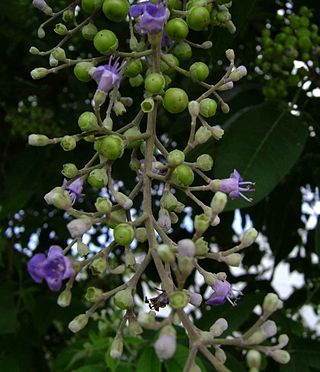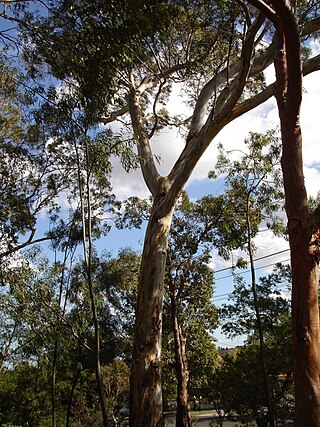
The Lamiaceae or Labiatae are a family of flowering plants commonly known as the mint, deadnettle, or sage family. Many of the plants are aromatic in all parts and include widely used culinary herbs like basil, mint, rosemary, sage, savory, marjoram, oregano, hyssop, thyme, lavender, and perilla, as well as other medicinal herbs such as catnip, salvia, bee balm, wild dagga, and oriental motherwort. Some species are shrubs, trees, or, rarely, vines. Many members of the family are widely cultivated, not only for their aromatic qualities, but also their ease of cultivation, since they are readily propagated by stem cuttings. Besides those grown for their edible leaves, some are grown for decorative foliage. Others are grown for seed, such as Salvia hispanica (chia), or for their edible tubers, such as Plectranthus edulis, Plectranthus esculentus, Plectranthus rotundifolius, and Stachys affinis. Many are also grown ornamentally, notably coleus, Plectranthus, and many Salvia species and hybrids.

Vitex agnus-castus is a plant native of the Mediterranean region. It is one of the few temperate-zone species of Vitex, which is on the whole a genus of tropical and subtropical flowering plants. Vitex is a cross-pollinating plant, but its self-pollination has been recorded.

Mauritia flexuosa, known as the moriche palm, ité palm, ita, buriti, muriti, miriti (Brazil), canangucho (Colombia), morete or acho (Ecuador), or aguaje (Peru), is a palm tree. It grows in and near swamps and other wet areas in tropical South America.

Plectranthus verticillatus, Swedish ivy, Swedish begonia or whorled plectranthus is a plant in the family Lamiaceae (Labiatae), genus Plectranthus. Despite its common name, it is not close to the ivy family of the genus Hedera.

Vitex is a genus of flowering plants in the sage family Lamiaceae. It has about 250 species. Common names include chaste tree or chastetree, traditionally referring to V. agnus-castus, but often applied to other species, as well.

Vitex trifolia, the simpleleaf chastetree, is a large coastal shrub or small tree.

Justicia adhatoda commonly known in English as Malabar nut, adulsa, adhatoda, vasa, vasaka, is native to Asia. Adathoda means 'untouched by goats' in Tamil. The name derives from the fact that animals like goats do not eat this plant due to its extreme bitter taste.

Eucalyptus leucoxylon, commonly known as yellow gum, blue gum or white ironbark, is a species of small to medium-sized tree that is endemic to south-eastern continental Australia. It has smooth yellowish bark with some rough bark near the base, lance-shaped or curved adult leaves, flower buds in groups of three and cylindrical, barrel-shaped or shortened spherical fruit. A widely cultivated species, it has white, red or pink flowers.

Vitex parviflora is a species of plant in the family Verbenaceae, also known as smallflower chastetree or the molave tree. The name "molave" is from Spanish, derived from mulawin, the Tagalog word for the tree. It is also known as tugas in Visayan languages. It yields one of two woods from the same genus called molave wood, the other being Vitex cofassus.

Vitex negundo, commonly known as the Chinese chaste tree, five-leaved chaste tree, or horseshoe vitex, or nisinda is a large aromatic shrub with quadrangular, densely whitish, tomentose branchlets. It is widely used in folk medicine, particularly in South and Southeast Asia.

Boerhavia coccinea is a species of flowering plant in the four o'clock family which is known by many common names, including tar vinescarlet spiderling and red boerhavia.

Vitex pinnata is a tree of the family Lamiaceae. It is native to south and south east Asia. It grows slowly, ultimately reaching 20 metres in height with 1–3 m. circumference trunk. It features a grey-brown-yellow bark. Its leaves are scented.
Dogo or Doro (Dɔ́rɔ́) is a village and administrative centre (chef-lieu) of the commune of Bimbéré Tama in the Cercle of Youwarou in the Mopti Region of southern-central Mali.

Bertolonia is a genus consisting of 14 species of pretty, dwarf, creeping, tender perennials, native to tropical South America. These herbaceous plants are grown for their colorful, velvety, ornamental foliages, vary from shimmery white with purple, pink with purple, or bronze-green with carmine and lighter midribs, purple beneath. Leaves are coarsely hairy, oval 7 cm (3 in) long on short stalks. The plants bear clusters of small, bell-shaped flowers repeatedly, just above the leaves, color ranges from pink, red, yellow to purple.

Vitex rotundifolia, the roundleaf chastetree or beach vitex, is a species of flowering plant in the sage family Lamiaceae. It is native to seashores throughout the Pacific. Its range includes continents and islands stretching from India east to Hawaii and from Korea south to Australia. This shrub typically grows approximately 1 m in height. It has a sprawling growth habit and produces runners that root regularly at nodes. This rooting pattern allows the plant to spread rapidly. At maturity, V. rotundifolia produces blue-purple flowers that are borne in clusters and ultimately yield small brown-black fruits. Its leaves are rounded at the tips with green upper surfaces and silver lower surfaces. While the plant is a seashore obligate, it grows over a wide latitude range. It has been used for medicinal purposes throughout its native range. More recently, it was imported to the eastern United States where it has become a seashore invasive. Control efforts are presently underway to protect the fragile beach dune ecosystem.
Vitex divaricata is a tree shrub of the Caribbean native to Puerto Rico and the US Virgin Islands. Its Spanish vernacular names include higüerillo and higuerillo. Its English vernacular name is white fiddlewood. It belongs to the order Lamiales. This tree is common in the Toro Negro State Forest.

Vitex altissima, the peacock chaste tree, is a species of woody plant reaching some 20 m in height, in the family of Lamiaceae. It is native to the Indomalayan realm, namely Bangladesh, India, Indonesia, Myanmar, and Sri Lanka, and is also found in New Guinea. Its greyish bark becomes scaly with maturity. The leaves are trifoliolate or palmate, compound and opposite. They are elliptic or elliptic-lanceolate in shape with acuminate apex and cuneate base. The margin is serrate or sometimes entire. The inflorescences are in terminal panicles. The corolla is bluish white. The purplish black fruit is a four-seeded drupe.
Vitex thyrsiflora is a species of woody vine in the family Lamiaceae. It is native to tropical West and Central Africa. Its hollow stem is used as a home by an aggressive species of ant.















